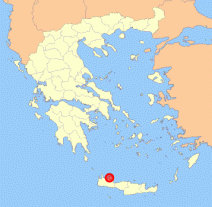
 On our way to Chania, last stop on our tour to the four corners of Crete, we decided to make a short detour and to visit the two monasteries of Akrotiri peninsula, often classified as “must-see” of the island. The first, moni Tzagarolon, is well worth its reputation. The second, moni Gouvernetou, was closed for restoration works so we have to content ourselves with a hike down to the deserted monastery of Katholikon. And it was really unique!
On our way to Chania, last stop on our tour to the four corners of Crete, we decided to make a short detour and to visit the two monasteries of Akrotiri peninsula, often classified as “must-see” of the island. The first, moni Tzagarolon, is well worth its reputation. The second, moni Gouvernetou, was closed for restoration works so we have to content ourselves with a hike down to the deserted monastery of Katholikon. And it was really unique!
[sam id=”7″]
Coming from Rethymno, we left the ‘national road’ turning right to Chania and Souda and then following the signs to the airport. Few words about this disgraceful highway. It’s a poorly conserved and dangerous road, mostly with one and a half lane without central guardrail, where speeding trucks go side by side with rented motorbikes from the adjacent tourist areas. This situation results in hundreds of fatal and serious accidents every year. Of course it is supposed to change as a new highway is scheduled to be built. The planning started decades ago, just don’t ask when it will be completed…
Agia Triada Monastery
We arrived at the monastery of Agia Triada (meaning Holy Trinity) or Tzagarolon [35.56055,24.13453] 20 kms after the exit. The monastery is built at the north-east tip of the Akrotiri peninsula surrounded by olive trees and vineyards. It’s a blessed place, whatever your point of view may be. The building is highlighted as one of the finest examples of Crete’s Renaissance architecture. It was created by two brothers, Jeremiah and Laurentius Tzagoroli, heirs of a powerful and wealthy Veneto-cretan family, at the begging of the 17th century. According to the legend, they were monks expelled from the nearby monastery of Gouverneto, because of their Latin origin; after that they decided to built their own monastery. The truth may be much more prosaic. Jeremiah was appointed by the ecclesiastic authorities to revitalize an abandoned monastery that stood on the same site using his wealth and of course his good taste and educational background. The main church follows the style of Mount Athos monasteries influenced by the Venetian architecture.
Although the monastery complex was burnt down during the Ottoman occupation, it remains relatively intact showcasing some fine examples of the Cretan icon painting School. It is open daily from 8.00 till 20.00 and the entrance ticket is 2 euro (for foreigners only…). Don’t forget to stop by the shop (open daily from 9.00 till 17.30), definitely not for the ordinary religious souvenirs but for the top quality organic olive oil produced on the monastery’s estates.
Gouverneto & Katholikon Monasteries
The monastery of Gouverneto or Our Lady of the Angels [35.58248,24.13982] is standing few kilometers away. It is considered one of the most important of Crete’s due to its long-standing history (it was built in 1537). Unfortunately it was closed to the public during our visit and nobody seems to know when it will be open. Nevertheless we entered the outer door, which was open, and after we passed the closed monastery we continued down to the hill heading towards the gorge of Avlaki. On our path we saw a sign prohibiting (among other things) even the swimming in the beach of Avlaki, not for safety reasons of course but because it is considered disrespectful (I suppose). For the history: one year ago there was an violent incident between the prior of the monastery and a Greek family who claimed their right to swim there. The sea doesn’t belong to the monastery; besides that, according to the Greek law, the coastline is a public property and everybody has the right to access it, even if he/she has to pass through a private area (at least for the moment). Anyway, it is a rather sad story and unless you want to fight for your rights it is preferable to avoid any confrontation with the absurd.
We continued our way along the path and after few minutes we arrived at Arkoudospilos (Bear Cave which means that there is a rock reminding a bear) with a small chapel inside. A bit further down we arrived at the magnificent Katholikon, an abandoned monastery of unknown origin and the cave of an hermit known as Saint John the Stranger. The most impressive structure is a huge bridge over a dried river. The whole hike took us about one hour not counting the stops.
[sam id=”7″]
